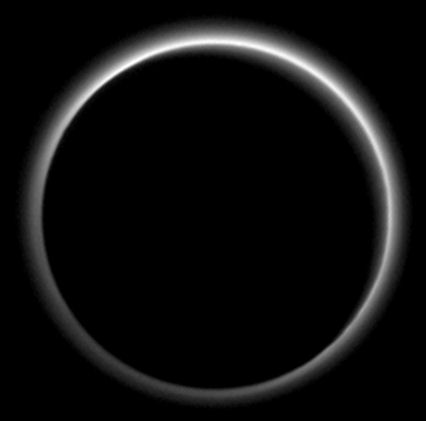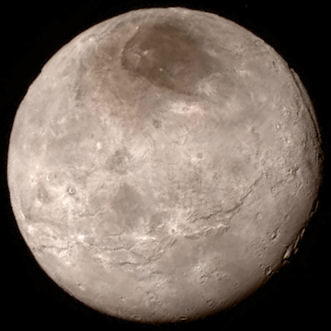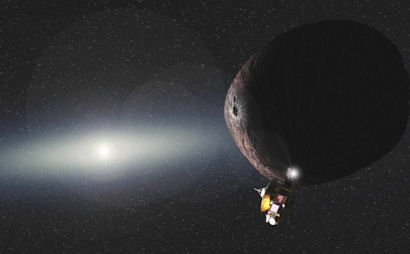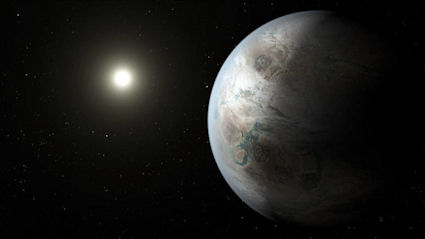
Andy Lloyd's Dark Star Blog

Blog 28 (July 2015)
Puzzling Pluto Reveals its Secrets
NASA's New Horizons probe has finally made its way
past distant Pluto, after a nine year voyage through the planetary zone
of the solar system. I write this shortly after it passed the
planet (surely Pluto will be elevated back to proper planetary status
given the remarkable properties it's now known to exhibit?), and the
release of a new image released by NASA, taken at a distance of half a
million miles (right (1)). It's early days to comment on what
we're seeing here, particularly as there is the prospect of a huge
amount of new data coming back to scientists from the distant probe over
the next couple of months which will bring far greater clarity to the
geophysical picture on display. But some of its features jump out
at me straight away.
Pluto. Image credit: NASA/JHUAPL/SwRI Pluto is quite obviously proving to be a far more
interesting world than was anticipated by pretty much anybody.
It is not the grey, dull world so reminiscent of, say,
most of the dwarf planets in the asteroid belt. Instead it is
reddish, or more precisely salmon pink in colour: "It clearly shows the dwarf
planet's surprising Mars-like reddish hue, and the enigmatic
heart-shaped feature on its surface that has already become Pluto's
calling card on the internet... The dwarf planet's unusual colour has
also enthralled scientists. Far from being a drab grey, as expected, it
turns out to be salmon red. Experts believe the colour arises from
the chemical action of sunlight generating red compounds in the
atmosphere that then fall on the surface. "...[NASA]'s administrator
Charles Bolden - who insisted on giving Pluto its old title of planet -
said: "I'm fascinated personally by the colour of the planet. I expected
to see a cold, grey planet on the edge of the solar system, but we see a
planet with this reddish tint not unlike Mars."" (2) As it turns out, Pluto reddening had been noticed
from images of the planet taken by the Hubble Space Telescope. The
red colour has become more dramatic over the last ten years than in
previous decades, a change which is thought to be due to the solar wind
stripping away hydrogen from the methane surface ices leaving dark,
reddish organic compounds exposed (3). It's not the first time that red dwarf planets have
been discovered in the outer solar system. Neptune's largest moon
Triton is pink, and exhibits a retrograde orbit suggesting that it is a
captured object (4), perhaps originating from the Kuiper Belt. The reddest of the
known Kuiper Belt Objects is
the enigmatic Sedna, which is second only to Mars itself in its redness. Sedna is remarkable for a number of things, the most
bizarre being its highly elongated orbit which, according to planet
hunter Dr Mike Brown, is clearly indicative of the dwarf world having
been perturbed by a sizeable outside influence some time in the past
(5). Compared to the rest of the planets in the solar system,
Pluto's vast orbit is off-kilter and elliptical. Perhaps it too
was perturbed by the same outside influence that Dr Brown mentions.
So what makes this red colour appear on the surface
of these distance worlds? Deposition of organic materials onto the
surface (created by the sun's dim UV light working on the volatile
compounds of the thin atmospheres) could be the reason, although it
should be noted that this redness is certainly not common to all of
these Trans-Neptunian Objects. Another factor might be high speed,
collisional interactions, which in Sedna's case seems all the more
possible given its highly eccentric orbit (6).
A backlit Pluto reveals the extent of the planet's
atmosphere
Image Credit: NASA/JHUAPL/SwRI (7) It's now known that Pluto has an atmosphere of
nitrogen, methane and carbon dioxide (2), which is perhaps thicker
during its long perihelion passage than when it resides about a third as
far away again at aphelion. Truly remarkable images sent back from
New Horizons on 23rd July show a backlit Pluto with hydrocarbon
atmospheric hazes extending to about 80 miles above the planet's
surface, significantly greater than scientists had anticipated (7). The
new atmospheric data suggests the
deposition of reddish organic materials (tholins) onto its surface, leading to
its darker colour. "Scientists had previously
calculated that temperatures would be too warm for hazes to form at
altitudes higher than 20 miles (30 kilometers) above Pluto’s surface.
With New Horizons detecting hazes at up to 80 miles (130 kilometers),
“We’re going to need some new ideas to figure out what’s going on,” said
[Michael]
Summers
[a New Horizons co-investigator from George Mason
University, Virginia]." (7) 

A Family of Dark Intrigue
Also, the existence of the sizeable moon Charon strongly indicates a major collision between Pluto and another celestial body in the distant past. This collision may have placed Pluto into its eccentric orbit, or perhaps the same major external influence (a Dark Star way beyond Neptune? (8)) which perturbed Sedna so dramatically?
Pluto has many more surprises up its sleeve, all of which point to a dramatic past. I think that its claim to be a proper planet has been greatly enhanced.
"Other photos taken from a million miles away revealed evidence of cliffs, craters and chasms larger than the Earth's Grand Canyon. Pluto looks and behaves like a fully fledged planet, having an atmosphere and no less than five moons of its own. The dwarf planet is somewhat larger than previously thought, having a diameter of 1,473 miles. The result confirms that Pluto is larger than any other known solar system object beyond the orbit of Neptune." (2)
Its curious surface features include a bright, prominent 'heart' (1) and various areas which appear to have been substantially re-worked over time, suggestive of interior geophysical processes in play:
"The image shows for the first time that some surfaces on Pluto are peppered with impact craters and are therefore relatively ancient, perhaps several billion years old. Other regions, such as the interior of the heart, show no obvious craters and thus are probably younger, indicating that Pluto has experienced a long and complex geological history. Some craters appear partially destroyed, perhaps by erosion. There are also hints that parts of Pluto’s crust have been fractured, as indicated by the series of linear features to the left of the heart." (1)
There have also been hints of a sub-surface ocean. Pluto's companion Charon is relatively large for a moon - even more so than the Moon's relative size to the Earth (both might be consider binary planets). It likely formed following a catastrophic collision between Pluto and another cosmic body. This process served to heat Pluto's interior, enabling a liquid ocean to exist possibly to the current day (9). Such an ocean is likely to lie ~60 miles below the surface, however, and contain ammonia and salt impurities driving down its freezing point (10).

Charon. Image Credit: NASA-JHUAPL-SwRI
For both bodies, their mutual tidal heating likely continues to drive internal heating mechanisms, helping to explain the extent of re-surfacing over ancient craters across the landscapes of both Pluto and Charon, including Pluto's now famous 'heart'. Charon's orbit around Pluto was likely more eccentric in the past, exacerbating the effect of tidal friction in the past. The following geophysical prediction from 2014 appears to be bearing fruit:
"If New Horizons finds evidence of ancient tidally-driven tectonic activity on either body, the most likely explanation is that Pluto had an internal ocean during Charon’s orbital evolution." (11)
NASA's data from New Horizons does seem to confirm this for Charon:
"A swath of cliffs and troughs stretches about 600 miles (1,000 kilometers) from left to right, suggesting widespread fracturing of Charon’s crust, likely a result of internal processes. At upper right, along the moon’s curving edge, is a canyon estimated to be 4 to 6 miles (7 to 9 kilometers) deep." (12)
Pluto's varied surface includes dramatic mountains, likely consisting of water ice, whose composition at Pluto's extreme temperature ranges creates a much stronger building material than methane/nitrogen ice. These are youthful mountains likely formed in the last 100 million years - an estimate based upon a surprising lack of craters in their vicinity:
"“This is one of the youngest surfaces we’ve ever seen in the solar system,” says Moore. Unlike the icy moons of giant planets, Pluto cannot be heated by gravitational interactions with a much larger planetary body. Some other process must be generating the mountainous landscape. “This may cause us to rethink what powers geological activity on many other icy worlds,” says GGI [Geology, Geophysics and Imaging] deputy team leader John Spencer of the Southwest Research Institute in Boulder, Colo." (13)
So, the ice mountains likely arose from the water-ice bedrock below Pluto's surface, a layer which itself may cover a deeper aqueous ocean. Other areas of Pluto are covered in wide fields of glaciers flowing across the planet's surface. The intense cold at this distance from the Sun (minus 235C) means that these are highly unlikely to be made of water ice: the properties of water ice at this temperature which helped to form the rugged ice mountains don't lend themselves to malleable ice flowing across a surface. Instead, these glaciers are likely to consist of nitrogen, carbon monoxide and methane, and are likely still slowly flowing over Pluto's ancient craters today (14).
Pluto's active features are thus providing insight into a multi-layered, complex world. Perhaps life, in the form of extremeophiles, might also exist deep within the planet, submerged in dark, warm oceans. What is clear from all this is that Pluto is far from being a dead lump of frozen rock. The surprise here is that, unlike many of the outer solar system moons, Pluto is not in the vicinity of a gas or ice giant planet (which provide their moons with tidal warming, and immersion within a strong magnetic field). Nonetheless, it experiences internal processes, like tectonic and volcanic activity, which cause widespread re-surfacing.
Pluto's Catastrophic Past
Its moon Charon played, and may still contribute a part in this. Charon's very existence most likely points to a previous catastrophic collision which created the moon, boiled Pluto's interior and set the consequent binary planet system onto its irregular orbital path. Pluto's almost perfect spherical shape indicates that at some point in its past it must have been spinning very quickly, likely as a result of the giant impact which led to the creation of Charon (14). Furthermore, Charon's orbit around Pluto is now fairly circular, pointing to a settling of its orbit over a long period of time. In this same way, Charon's tug on Pluto slowed its spin over time.
So, the planetary collision which affected Pluto must have been a very long time ago. What caused it? Was it anything to do with Sedna's odd orbit, or that of the other so-called scattered disk objects beyond the regular Kuiper Belt? Are these distant cosmic footprints of catastrophism more evidence for the existence of a much larger body further out in the solar system? I think so. Clearly, the outer solar system continues to surprise everyone.
It's a curious thing that this proposed formation of the Pluto/Charon planetary couple essentially mirrors that of the Earth/Moon coupling. What are the odds that two planets in the solar system both get whacked early on, forming massively over-sized moons? I would think the odds for this are pretty long, yet here we are. Perhaps this suggests that something else is going on which no one has yet guessed at. Either way, the occurrence of early catastrophism in the outer solar system is confirmed by these findings by the New Horizons probe, leading us towards a realisation that the previously bland modelling of the zone beyond Neptune is at odds with reality.
Another important point for those considering the existence of Nibiru: Like Saturn's moon Enceladus, Pluto is now known to be far more active than theoretical models suggested. Scientists must now consider other mechanisms driving these kinds of active internal processes in planets, especially those located in relative isolation from other sizeable worlds. Such mechanisms might then apply to theoretical Planet X bodies, like Zecharia Sitchin's Nibiru (15), providing us with a distant world which is potentially habitable. The Dark Star solution (8) still seems the better possibility to me, but no longer can sceptics legitimately argue that the outer solar system is a dead pool.
Where to Next for New Horizons?
The New Horizons mission will continue to provide scientists with a staggering amount of data about the Pluto system over the next year or so, and has already proven itself as a great success in wowing the world. However, the second half of its mission, to conduct a flyby of a suitably large Kuiper Belt Object, is not going so well. Ground-based initiatives to target a suitable candidate KBO have not hit the jackpot (16): the more exciting prospects are not within range of New Horizon's potential cone of trajectories: the probe is capable of some limited manoeuvrability, which would preferably need to be instigated early into the next 15 years of its continuing mission (17).
With the poor results from ground-based surveys for KBOs, the Hubble Space Telescope (HST) was been put brought into the increasingly urgent search:
"Hubble will search a small area of the sky, located near the constellation Sagittarius, examining some of the objects New Horizons could reach. To find KBO's among the vast multitude of background stars, mission planners will employ a unique photographic trick. They will turn the telescope at the predicted rate the distant bodies should be orbiting the sun. Theoretically, KBO's should be seen in images as dots, while stars will be streaked. If two or more objects are seen with a given minimum brightness, mission planners believe there is a statistical chance a good target could be found. If this test is successful, the search area will be expanded to a region approximately half a degree across - roughly the size of a full moon as seen from Earth." (18)
This area of the sky is a difficult zone to find distant, dim objects in. It lies in the Galactic Plane, providing the celestial equivalent of hunting for a needle in a haystack. It is also the general region of the sky where I suspect the Dark Star is located - its direct observation likely scuppered by similar issues (19).

New Horizons arrives at its next target
If a suitably sized KBO was not found within the required search area in the near future, the New Horizons probe might have been able to fall back on making some long-distant observations of several possible KBO candidates, each observed by the HST. In keeping with Pluto's colouration, all three of these KBOs are red in colour, "consistent with the expectation that most of the targets in the search area will be members of the 'Cold Classical population'" (20). As it turned out, Hubble came up trumps, locating several candidate objects early in its search. The prime candidate, 2014 MU69, named 'PT1' by the New Horizons team, is between 30 and 45km in diameter, has a circular orbit and also belongs to the 'Cold Classical population' in the Kuiper Belt (21). The rendezvous, if 2014 MU69 is chosen, would be in January 2019 at a distance of 43.4 AU. 2014 MU69 may be a pristine primordial solar system object, or it might be left-over debris from a cosmic collision (22).
Written by Andy Lloyd, 14-26th July 2015
References:
1) Tricia Talbert (Ed) "New Horizons Spacecraft Displays Pluto’s Big Heart" 14 July 2015
2) Press Association "New Horizons spacecraft captures pictures in historic Pluto fly-by" 14 July 2015 (Article on longer online)
3) Seth Borenstein "Pluto Turning Red Due To Solar Flares, Southwest Research Institute In Boulder Colorado Determines" 6th April 2010 (Article on longer online)
4) "Triton"
5) Elizabeth Howell "Sedna: Possible Dwarf Planet Far From the Sun" 30 April 2015
6) Andy Lloyd "Sedna: A Clue to Nibiru" 15 March-21 April 2005
7) Tricia Talbert "Stunning Nightside Image Reveals Pluto’s Hazy Skies" 24 July 2015
8) Andy Lloyd "Dark Star: The Planet X Evidence" Timeless Voyager Press 2005
Dark Star: The Planet X Evidence
9) Stephen Luntz "A Subsurface Ocean on Pluto?" 16 April 2014
10) Joelle Renstrom "Pluto May Have A Subsurface Ocean, Saturn May Be Forming A New Moon" 16 April 1015
11) A. Barr & G. Collins "Tectonic Activity on Pluto After the Charon-Forming Impact" 25 Mar 2014
12) Tricia Talbert (Ed) "Charon’s Surprising, Youthful and Varied Terrain" 15-16 July 2015
13) Tricia Talbert (Ed) "The Icy Mountains of Pluto" 16 July 2015
14) Calla Cofield "Amazing Photos of Pluto Reveal Glaciers and Hazy Atmosphere" 24 July 2015
15) Zecharia Sitchin "The Twelfth Planet" Avon 1976
16) Matthew Francis "Will New Horizons Find the Next Pluto?" 15 July 2015
17) Alexandra Witze "Pluto-bound probe faces crisis" 20 May 2014
18) James Maynard "Hubble hunts for Pluto probe New Horizon's next target" 17 June 2014
19) Andy Lloyd "Planet X and the South Pole Telescope" 4 May 2006
darkstar1.co.uk/sagittarius.html
20) S. Benecchi, et al. "New Horizons: Long-range Kuiper Belt targets observed by the Hubble Space Telescope" Icarus, 246: 369–374, 15 January 2015
21) "2014 MU69" (later named "486958 Arrokoth")
22) Emily Lakdawalla "Finally! New Horizons has a second target" 15 October 2015
The Sumerian Pluto
One might wonder what Zecharia Sitchin would have made of these
developments. His translations and analysis of ancient Sumerian
texts led him to propose that the grand Mesopotamian epics about their
pantheon of gods were actually codified descriptions of cosmic events in
the solar system (1). In other words, the science of the solar
system, provided by the flesh-and-blood 'gods', or Anunnaki, who
temporarily colonised the Earth, was handed down to the Sumerians in the
form of myths and legends. In other words, in a format that they
would understand and pass on. This is not such a leap as one might
expect, as many of these texts (e.g the Babylonian 'Enuma Elish' (2))
are full of references to the heavens, stars and movement of the cosmic
'gods'.
The late Zecharia Sitchin
Sitchin discusses Pluto only briefly in his books. The Sumerians
counted it as one of the planets proper (while we have shamefully
degraded its status), and called it 'Gaga'. It was initially one
of the moons of Saturn (Anshar), which was
'loosened from his course' by Marduk (the Dark Star/Nibiru)
(3), "imparting to it some of Marduk's
own orbital characteristics (such as a different orbital plane)"
(4). This implies a tremendous degree of catastrophism to have
shifted the planet that far away from its initial position; certainly
enough to cause many of the properties of the Pluto system now observed.
Some of my research colleagues have fleshed out some further details.
Here's some thoughts from author Al Cornette on the Dark Star/Planet X
forum: "That early collision could
well have been a satellite of Planet X. I still find it incredibly
plausible and accurate what Sitchin did with the Creation Myth. "Anshar
opened his mouth, To Gaga, his Counsellor, a word he addressed . . . Be
on thy way, Gaga, take the stand before the gods, and that which I shall
tell thee repeat thou into them." Something came so close to Saturn that
one of its satellites (Gaga) was ripped from its orbit and shunted to
the present position of Pluto. This is so exciting for me and I
certainly wish they (NASA) would show us close up detail."
(5) Author Phil Whitley provides further thoughts, based
on some of Zecharia Sitchin's later works: "Andy, Sitchin updated his
thoughts on Nibiru's orbit period from 3600 to 3450 years after the pass
of 12,500 years ago. On this pass (which was one of the worst), one of
its moons struck Pluto (Gaga), tilting its axis. That moon of Nibiru was
captured by Uranus and is
now called Miranda. Nibiru's orbit was changed just enough to come
closer to Earth and cause the Great Flood and end the ice age."
(6) Written by Andy Lloyd
References:
1) Zecharia Sitchin "The Twelfth Planet" Avon 1976
2) 'Enuma Elish: The Epic of Creation' L.W. King (Translator)
3) Zecharia Sitchin "The Twelfth Planet" Avon 1976, p222
4) Zecharia Sitchin "The Twelfth Planet" Avon 1976, p234
5) Correspondence from Al Cornette, 18 July 2015
6) Correspondence from Phil Whitley, 19 July 2015
Dr Hermann Burgard Makes Contact
Regular readers may recall me discussing the work of German researcher
Dr Hermann Burgard, a noted European civil servant (now retired) and
linguistic scholar who has translated the Sumerian
"Temple Hymns of Enheduanna", written about 2,300BCE
(1). His transliterations seem very Sitchinite,
yet are independently translated from the original ancient cuneiform
texts (2,3). I had trouble tracking him down, but luckily he found
my reference to his work on the Dark Star Blog, and got in touch by
email: Dear Mister Lloyd, By chance I realized you
mentioning my translation of the Temple Hymns. Part II has been
published recently but still only in German under the title
“Encheduanna : Verschlüsselt-Verschollen-Verkannt, Tempelhymnen 20 – 42”.
All findings of Part I are confirmed with new technologies and
astonishing details a woman high Priest can not have invented
around 2,300 B.C. and ascribing these things to “Deciders” acting long,
long before... Kind regards Dr. Hermann Burgard It's good to see that Dr Burgard has produced a
further translation of these remarkable Temple Hymns; Part 2 of which
was published in August 2014 and is now available to a German-speaking
audience. I've written back to him hoping to glean some more
detail - in English - and will continue to keeps readers updated with my
progress regarding his important contribution to the understanding of
ancient Mesopotamian texts.
Written by Andy Lloyd, 18th July 2015
References:
1) Andy Lloyd "Sumerology Rechallenged" 15 May 2014
andylloyd.org/darkstarblog12.htm
2) Andy Lloyd "More about Dr Hermann Burgard"
andylloyd.org/darkstarblog13.htm
3) Erich von Däniken, "Remnants of the Gods", New Page Books, pp121-2, 2014
4) Correspondence from Dr Hermann Burgard, 4 July 2015
Destruction of Mesopotamian Artifacts
Last month, I highlighted similarities between a number of artifacts which shared the solar cross motif in common, including a Mesopotamian Winged Disk from the 'Banquet Stele' discovered in 1951 in the ancient Palace of Nimrud in modern-day Iraq (1). Nimrud was an ancient Assyrian city dating from the 13th Century BC, but is thought to have been inhabited for over 7000 years (2).

IS militants destroying statues in Mosul in February 2015
Depressingly, it was the subject of a fanatical cultural attack by the so-called Islamic State back in March:
"On March 5, 2015, ISIL reportedly started the demolition of Nimrud, an Assyrian city from the 13th century BC. The local palace was bulldozed, while lamassu statues at the gates of the palace of Ashurnasirpal II were smashed." (3)
This trail of destruction followed on from the indiscriminate and wanton vandalism of the ancient Nineveh at ISIL-occupied Mosul, the museum of which was comprehensively ransacked (4).
According to a local tribal source, Nimrud was looted of its valuables, then completely levelled to the ground (5). Justification for this cultural destruction takes the form of a distorted religious conviction that shrines and statues represent false idols, the worship of which must be stopped through the use of sledgehammers and bulldozers. It goes without saying that this is utter lunacy, reminiscent of the cultural cleansing of the Conquistadors in South and Meso-America.

The Banquet Stele from Nimrud
As far as the Banquet Stele of Assurnasirpal II goes, it remains safely housed in the British Museum (6), I'm happy to say. If any justification was ever needed for the removal of ancient artifacts from unstable parts of the world for cultural safe-keeping, then this is surely it. Yes, the British removed artifacts from Nineveh when they extensively excavated the site in the 19th and 20th centuries, and brought them back to London. Such activities by the European imperial powers of the time have often been criticised for effectively plundering then-occupied countries of their historical and cultural wealth. Of course, there is truth to this - but surely a welcome outcome has been the permanent relocation of these world treasures to more stable countries where they are safe from attack by these Islamofascist zealots?
The Syrian World Heritage Site of Palmyra is now in IS-controlled territory. So far, 'only' statuary has been attacked by them (3), but it is likely only a matter of time before an incident in the on-going civil war there provokes their ire sufficiently to get the bulldozers rolling.
Written by Andy Lloyd
, 25th July 2015
References:
1) Andy Lloyd "Radiant Solar Cross" 30 June 2014
andylloyd.org/darkstarblog27.htm
2) Jane Arraf "ISIL fighters bulldoze ancient Assyrian palace in Iraq" 5 March 2015
3) "Destruction of cultural heritage by ISIL"
wikipedia.org/wiki/Destruction_of_cultural_heritage_by_ISIL
4) Kareem Shaheen "Isis fighters destroy ancient artefacts at Mosul museum" 26 February 2015
5) BBC News "Nimrud: Outcry as IS bulldozers attack ancient Iraq site" 6 March 2015
6) "The Banquet Stele of Assurnasirpal II"
Earth's 'Big Sister' Discovered by the Kepler Team
The discovery of Kepler-452b has provided astronomers with the most Earth-like exoplanet yet, in the constellation Cygnus (1). At 1400 light years distance, we can know little about it at this point beyond its approximate mass, orbit and the properties of its parent star. But those facts are enough to get them buzzing (2), and put the media into a silly-season frenzy of speculation (3).

At about five times the mass of the Earth, Kepler-452b is most likely a rocky world 150% the size of Earth. It's gravity would be considerable, its true, but it's the orbit within its star's habitable zone which excites astronomers (its year is 385 days), combined with the fact that its Sun-like star is six billion years old: a significant period of time which potentially allows for the evolution of advanced life, all other things being equal.
Without wishing to rain on anyone's parade, there remains a distinct possibility that Kepler-452b is actually a 'small' gas giant, rather than a large terrestrial planet. But also, given that the solar system holds two binary planets (Earth and Pluto), Kepler-452b might also turn out to be a double planet? Until better telescopes go into service, we cannot know for sure. And Kepler-452b is just one of an ever-growing list of targets for them to examine:
"Astronomers say they now know from Kepler that about 10 percent of the 200 billion stars in the Milky Way have potentially habitable Earth-size planets, Kepler 452b probably among them. This means that of the 600 stars within 30 light-years of Earth, there are roughly 60 E.T.-class abodes, planets that could be inspected by a future generation of telescopes." (4)
It's natural for us to seek planets exactly like our own out there, hoping to discovery life elsewhere. But it's not necessary to do so: Habitable planets are as likely to be found around red dwarfs, brown dwarfs, or even as moons orbiting gas giants. Far from narrowing our search criteria, we should expect to find life of some form pretty much everywhere. The question is whether our catastrophe-prone universe really gives it a chance to get going sufficiently to look anything like us.
Written by Andy Lloyd
, 26th July 2015
References:
1) NASA Press release "NASA’s Kepler Mission Discovers Bigger, Older Cousin to Earth" 23 July 2015
2) Doug Bolton "Nasa announcement live: Earth 2.0 planet Kepler 452b discovered by Kepler Telescope" 23 July 2015
3) Doug Bolton "Earth 2.0: What we know about Kepler 452b, the most Earth-like planet ever discovered" 24 July 2015
4) Dennis Overbye "NASA Says Data Reveals an Earth-Like Planet, Kepler 452b" 23 July 2015
The Thunderbird
A beautiful new crop circle at Uffcott Down, nr Barbury Castle, Wiltshire appeared on 25th July 2015, showing what looks like a North American Indian 'Thunderbird' created with a Mayan/Aztec styling
(1).

Image Credit: Mr Gyro (3)
Author Greg Jenner wrote to me about the new design, saying:
"Hi Andy,
This latest crop circle has second sun overtones written all over it. It is of a Native Indian Thunderbird. My interpretation: Sol above the thunderbird's head. The thunderbird's head is a circle and cross (inside). Classic wing-like appearance.
Hmmmmmm. Very interesting indeed.
Regards: Greg Jenner" (2)
I agree entirely, and there has already been plenty of speculation about the various influences which have gone into this artistic creation on the fields of Wiltshire (3) . There are certainly Egyptian elements to this, in particular the solar disk above the bird's head, reminiscent of the ancient Egyptian god Horus. Additionally, the way that the bird is circumscribed by an (in this case imperfect) background circle is suggestive of Mesopotamian Winged Disks, for example those of the Zoroastrian god Ahura Mazda, or the Assyrian gods Ashur and Shamash. Indeed, one could call this a bit of a 'Sha-mash-up'. Very beautiful though. Hats off to the guys who created this outstanding artwork.
Written by Andy Lloyd
, 31st July 2015
References:
1) Mr Gyro "Crop Circles 2015 - Uffcott Down, nr Barbury Castle, Wiltshire"
2) Correspondence from Greg Jenner, 28th July 2015
darkstar1.co.uk/gregjennerindex.html
3) "Uffcott Down, nr Barbury Castle, Wiltshire" Reported 25th July
cropcircleconnector.com article
Meeting Al di Meola
I went to see
I had hoped that he would be doing an electric set, but the
intimate yet stunning venue (the historic Kunsthalle in Appenzell) was clearly orientated around acoustic music. Al was joined by a superb acoustic guitarist, from the US, whom I also had the opportunity to chat with, but whose name unfortunately now escapes me. The acoustic-orientated venue allowed Al and his band to play a lot of material from his new album 'Elysium', which is, I have to admit, quite challenging fusion jazz. I've been listening to it a lot recently and it has grown on me steadily over time. My cousin and her husband may have found it a little overwhelming as a music form, but if they were they were way too polite to say anything. At least, not in English!I'm glad to see Al recognised with a much-deserved 2015 Festival International de Jazz de Montreal Miles Davis award this summer. I hope he continues to create his remarkable, innovative music for many years to come!
Written by Andy Lloyd, 18th July 2015

You can keep informed of updates by following me on Twitter:
![]()
Or like my Facebook Page: https://www.facebook.com/darkstarandylloyd